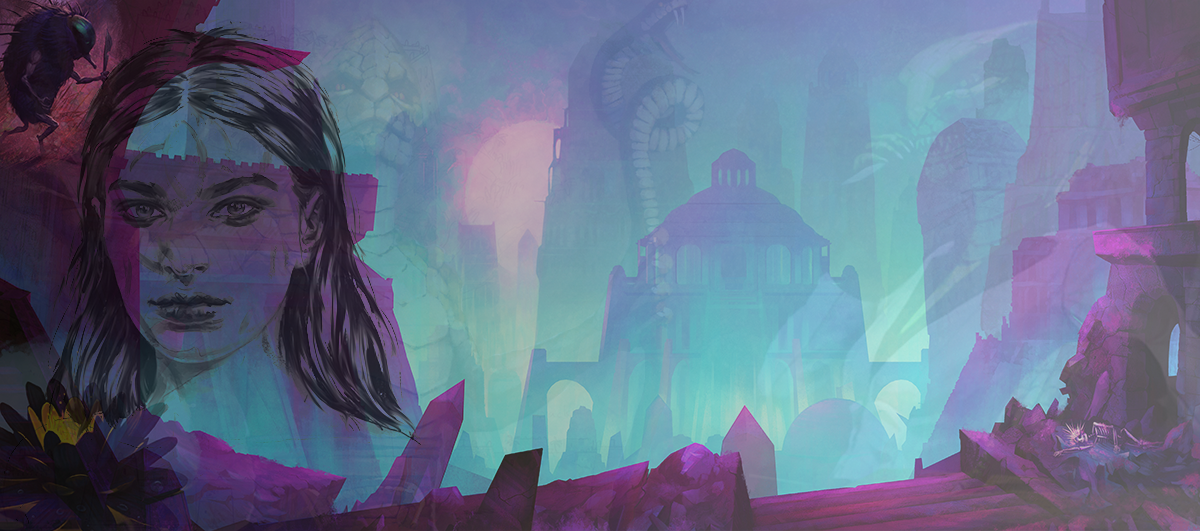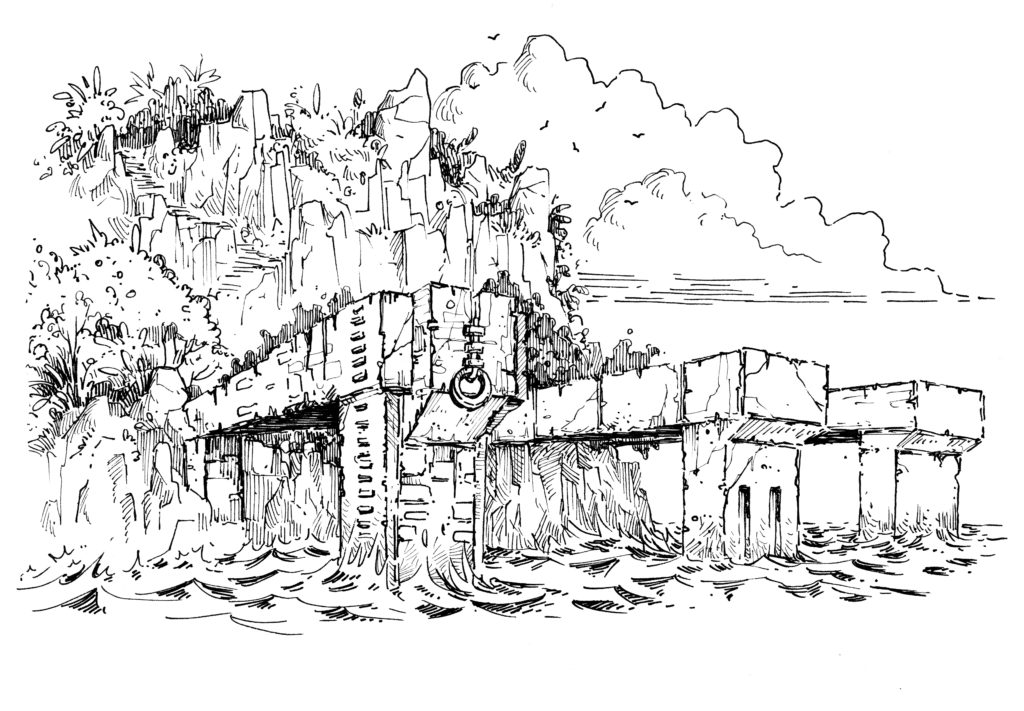
Journey To Carcosa
Carcosa is a fascinating place, a mythical land that was first written about by iconic author Ambrose Bierce and which was later adopted by a range of other writers before becoming a part of popular consciousness.
There’s a lot for us to talk about here and a lot of different sources to draw upon, so let’s cut to the chase and start travelling. Here’s everything you need to know about Carcosa.
Out Version of Carcosa
We draw inspiration from the more ephemeral representations of Carcosa. In Beyond The Black Sea, Carcosa is a world locked in an orbit with a black hole. Its a sword and sorcery setting mostly of bronze age or more primitive technology. We have several mini sagas set in Carcosa starting with The Skull. We also have our Aldebaran source book which details much of Carcosa, however this is a whole world and our intention is to create enough content for your gaming group to add what you need for the stories you want to tell.

Ambrose Bierce and Carcosa
The story of Carcosa begins with writer Ambrose Bierce and his 1886 short story An Inhabitant of Carcosa. In it, “the spirit Hoseib Alar Robardin” tells his tale, culminating with the iconic ending:
A level shaft of light illuminated the whole side of the tree as I sprang to my feet in terror. The sun was rising in the rosy east, I stood between the tree and his broad red disk – no shadow darkened the trunk!
A chorus of howling wolves saluted the dawn. I saw them sitting on their haunches, singly and in groups, on the summits of irregular mounds and tumuli filling a half of my desert prospect and extending to the horizon. And then I knew that these were the ruins of the ancient and famous city of Carcosa.
What’s interesting about this is that the city itself barely features in the story. It’s mentioned more in passing than anything, with very little description and the lens of time shrouding the truth about the city. By the time that the reader encounters it, the city has already been destroyed, and we hear about it from a character who used to live there.
So where does the name come from? Interestingly, it seems as though it’s just one of those names that captures people’s imagination, because it’s since been reused by more authors than you can shake a pen at. The leading theory for where Bierce got the name is that he’d heard of the French city of Carcassonne and that he simply modified the Latin name of “Carcosa”, but who knows?
Robert W. Chambers and Carcosa
Other writers to have used the Carcosa name and concept include Robert W. Chambers, who wrote, “I cannot forget Carcosa where black stars hang in the heavens; where the shadows of men’s thoughts lengthen in the afternoon; where the twin suns sink into the lake of Hali; and my mind will bear for ever the memory of the Pallid Mask. I pray God will curse the writer, as the writer has cursed the world with its beautiful stupendous creation, terrible in its simplicity, irresistible in its truth – a world which now trembles before the King In Yellow.”
So not somewhere you’d want to go on holiday, then.
Chambers’ use of Carcosa was as a part of his 1895 work The King in Yellow, where the author used the Carcosa concept along with a couple of Bierce’s other names including Hali (the lake with the twin suns) and Alar, a city that sits beside the lake. If you’re wondering about those twin suns, by the way, Carcosa isn’t a neighbouring planet to Tattooine. It’s said to be in the star cluster Hyades, the closest cluster of stars to our sun.
Other locations mentioned by Chambers include Demhe (with its “cloudy depths”), Hastur, Yhtill and Aldebaran. Not to be confused with Alderaan (what is it with these Star Wars similarities?), Aldebaran is a giant star about 65 light years from our sun. It’s the brightest star in the Taurus constellation and is nicknamed “The Eye of Taurus”, as well as the 14th brightest star in our night sky.
The King in Yellow also includes a short piece of poetry (technically it’s lyrics but without any music) called Cassilda’s Song, which you can listen to in the player below.
H. P. Lovecraft and Carcosa
Carcosa was later picked up by the legendary cosmic horror writer H. P. Lovecraft, who adopted it as part of his Cthulu mythos. This was an important boost for the Carcosa story because Lovecraft himself had a huge legion of admirers, including many writers who themselves expanded on the theme in their own work. On top of Lovecraft, these authors include Karl Edward Wagner, Lin Carter, James Blish and Charles Stross.
We should note, though, that Lovecraft never directly mentioned Carcosa in any of his short stories, or at least in the ones that were published. With that said, he did mention it in in an essay he wrote called Supernatural Horror in Literature. Sharing his experience with reading Chambers’ The Yellow Sign, he wrote, “After stumbling queerly upon the hellish and forbidden book of horrors the two learn, among other hideous things which no sane mortal should know, that this talisman is indeed the nameless Yellow Sign handed down from the accursed cult of Hastur – from primordial Carcosa.”
Lovecraft is also published alongside Chambers and other great writers like Arthur Machen and Edgar Allen Poe in a book called Shadows of Carcosa: Tales of Cosmic Horror. There’s also Lovecraft’s novella The Whisperer in Darkness, which mentions some key bits of lore including Hali and Hastur:
I found myself faced by names and terms that I’d heard elsewhere in the most hideous of [connections] – Yuggoth, Great Cthulhu, Tsathoggua, Yog-Sothoth, R’lyeh, Nyarlathotep, Azathoth, Hastur, Yian, Leng, the Lake of Hali, Bethmoora, the Yellow Sign, L’mur-Kathulos, Bran, and the Magnum Innominandum—and was drawn back through nameless aeons and inconceivable dimensions to worlds of elder, outer entity at which the crazed author of the Necronomicon had only guessed in the vaguest way. I was told of the pits of primal life, and of the streams that had trickled down therefrom; and finally, of the tiny rivulet from one of those streams which had become entangled with the destinies of our own earth.”
What Carcosa is Like
We’ve shared a few different excerpts throughout this article which should give you a good idea of what Carcosa is like, but there are a few more clues that we can take a look at. In The Repairer of Reputations, a short story in Chambers’ The King in Yellow, we get a few clues such as that there are black stars in the sky and twin suns that sink into Hali. It’s also said that “the shadows of men’s thoughts lengthen in the afternoon”.
In a short story called Litany to Hastur, author Lin Carter said that Carcosa has black domes and huge towers. More recently, Neal Wilgus wrote a piece for a 21st century King in Yellow anthology which reimagines the legend and has Carcosa as a mysterious small town in the backwaters of America. What’s cool about this is that they bring it into a modern era by having Hastur’s Hardware store and the Yellow Sign Hotel.
There’s even a direct line of inspiration and retelling linking Carcosa to Stephen King, whose Dark Tower series is loosely inspired by Robert Browning’s poem Childe Roland to the Dark Tower Came. In the same King in Yellow anthology, editor DT Tyrer wrote a piece also based on Browning’s poem and the fairy tales that it inspired in which the Dark Tower itself may just be one of the many towers in Carcosa.
Carcosa in Our World
By this point, you might be thinking that Carcosa doesn’t exist in our own world, and that’s true to a certain extent. That mythical place described by Bierce and Chambers might not exist, but there is a real world place called Carcosa that’s worth mentioning.
Back at the end of the nineteenth century, a building called the Carcosa Mansion was built as the official governmental residence of the Resident-General of the Federal Malay States. The first holder of the office was a guy called Sir Frank Swettenham, who’d read The King in Yellow and who’d liked the name. As recently as 2015, the building was being used as a hotel called the Carcossa Seri Negara, although don’t start booking your flights just yet as it’s now abandoned.
Carcosa has also been used as the name of two different publishing houses. The first was a specialist sci-fi publisher that was formed in 1947 by Frederick B. Shrover, Russel Hodgkins and Paul Skeeters. The second was founded in 1973 by David Drake, Karl Wagner and Jim Groce and published four collections of pulp horror.
Carcosa in Pop Culture
Because of its popularity in literature and fiction, Carcosa has also taken on an important place in popular culture. That means that it’s been reused and remixed in so many different places that it’s often hard to keep track. Just a few of my favourites include:
- True Detective: Here, Carcosa is a temple used by religious leaders and leading politicians in Louisiana, essentially depicting Carcosa as the heart of a cult which worships “The Yellow King”.
- The Chilling Adventures of Sabrina: There’s a character and a carnival named Carcosa, and it’s slowly revealed that all of the carnival workers are mythological beings and deities.
- DigiTech: This technology company has released a guitar effects pedal called Carcosa with two modes called Hali and Demhe.
- Mass Effect: In the third Mass Effect game, there’s a planet called Carcosa.
- A Song of Ice and Fire: In the fantasy series that inspired Game of Thrones, there’s a city of Carcosa that’s ruled by a sorcerer and which sits right at the far eastern edge of the known world on the shores of a huge lake.
- Joseph S. Pulver: This successful author has written dozens of stories based on the work of Robert W. Chambers, including Carcosa. He’s even acted as the editor for several Carcosa-themed anthologies.
And believe it or not, this is only the tip of the iceberg. Over the past hundred years or so, there have been so many additions to the Carcosa canon that we’ve only been able to note a few of the most popular and most interesting examples! There’s even a Carcosa-themed board game!
Conclusion
Now that you know just a little bit about Carcosa and its real world and fictional heritage, it’s over to you to keep the discussion going. Carcosa has become a little bit like Atlantis in that it’s entered the popular consciousness and been used all over the place as a result of it.
The location has been mentioned so often and in so many different works that it would be impossible for us to cover them all here, and so instead we took a look at just a few of the most noteworthy examples.
And so now it’s over to you so you can share your thoughts on Carcosa. Be sure to leave a comment so we can keep on chatting. I look forward to hearing what you think!t